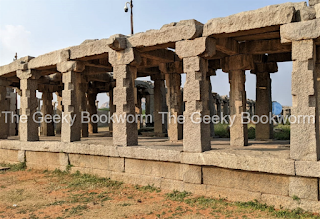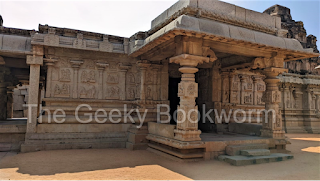Temples of Hampi
Immersed in rich cultural and historic heritage stands the tall and proud land of Hampi. Surrounded by majestic mountains of granite boulders on one side and the glorious river Tungabhadra on the other, the kingdom which was once the citadel of the vibrant Vijayanagara Dynasty invites history seekers from all over the world.
 |
| Vijaya Vittala Temple (pc: Rajni) |
Although Hampi was always on my bucket list, I never realized its grandeur till I visited it. As soon as one steps into Hampi, the golden era of King Krishna Deva Raya comes alive. Apart from this, one may be surprised to see the historical evidence of the Ramayan in Anegudi(north of Hampi).
Hence, to do complete justice to Hampi, I will be making 3 different posts highlighting the Sacred enclosure, the Royal enclosure and the Ramayan Trail.
Before I get started with the Sacred enclosure, it is important to note that Hampi was once a walled fortress made up of 8 concentric granite walls. In 1330s when the Kingdom was first established by the Royal family of Anegudi, the city was in constant turmoil with the Bahamani Sultanate of Bijapur. To protect their wealth and thrive, 8 concentric walls were made.
They were very well spaced and the entrance of each wall had a temple and a bazaar. There were 7 such massive temples out of which only 1 is currently functional. All the temples were built using an interlocking system.
 |
| Vijaya Vittala Temple Complex |
 |
| Stone Chariot at Vittala Temple |
The bazaars were so vast and affluent that traders from Persia, China and Magnolia reached Hampi to make their fortune. All over the district, there are around 3000 temples and it takes at least a year to delve into every nook and corner of this place. So let us start exploring Hampi with the Vijaya Vittala Temple.
After conquering Orissa, when Krishna Deva Raya returned to his capital, he sanctioned the construction of this temple as the symbol of victory. Hence the name Vijaya Vittala (Victorious Lord Krishna). The temple complex restored by ASI (Archaeological Survey of India) consists of the Kalyana Mandapa, Conference Hall, chanting hall and the main temple. It was based on Vastu Shastra (Traditional Indian system of Architecture).
 |
| Underground Pradakshina |
I had goosebumps while I walked around the sanctum sanctorum with minimal light from the tall ceiling. The style of the stone carvings on the walls is of Hoysala, Chozha, Chalukya and Konark architecture. Placed in front of the temple is a stone chariot, inspired by the Konark Stone chariot. A picture of this chariot is also found on all Rs. 50 notes.
Right outside, stretched for about 2km was once the Kudrai (Horse) Bazaar. Although in ruins, one can see mandapas resembling stalls stretched on both sides of a sandy road.
 |
| Horse Bazaar |
 |
| Carvings at Hazara Rama Temple |
 |
| Hazara Rama Temple |
The next temple on this virtual tour is the only ancient functional temple of Hampi, the Virupaksha temple. The only reason why this temple wasn’t looted and destroyed like the rest is that the Deity was adorned only with flowers.
The Shiva Ling here is said to have emerged on its own (Swayambhu). The Gopuram is made from brick and is carved to perfection. The interior pillar carvings were made from black granite of Warangal.
 |
| Virupaksha Temple |
One is blown away by the paintings on the ceiling made from organic vegetable colours.
These elaborate paintings depict the story of Lord Shiva and Parvati, the birth of their son Karthikeya and the destruction of Tarakasura.
Right in front of the temple was once a jewellery bazaar. As I stepped into the temple, it was as if I was transported 500 years back to witness the energy and exuberance of the temple complex.
Closing my eyes, I could see the entire temple decorated by beautiful marigold flowers, excited women shopping and the entire area buzzing with trade!
The most elusive and mystical temple of Hampi is the Prasanna Virupaksha temple. Although it isn’t an active temple, it is indeed extraordinary as it is immersed in water.
 |
| Ceiling painting at Virupaksha Temple |
 |
| Jewellery Bazaar at Virupaksha Temple |
 |
| Prasanna Virupaksha Temple |
If you would like to read about Hampi, I highly recommend ‘A
Forgotten Empire’ by Robert Sewell.



Very nice account of Hampi visit. The ruins of Hampi are in the same league of Angkorvat in Cambodia. By the grace of God we still have something left and all I not lost to the invaders and looters. Well written and quite informative.
ReplyDeleteI hope to write about several other places that have a deep historical significance.
Delete